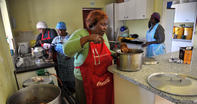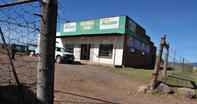Otto Qayiya’s Annual Return

The day after Otto came home for his December holiday, we would buy a sheep to slaughter for the celebration. Otto and I would go to our neighbour Mr Madondile and pay him R300 or R400 in cash and that afternoon one of Mr Madondile's sons would bring us the animal. He and Otto would slaughter it. When our own sons Vusi and Phumie were old enough, they would do it.
It's not difficult - they grow up seeing it done, so they know how. We called our friends, neighbours and family to have a party, with dancing and music, which lasted all of Saturday. It was always a wonderful weekend. When the meat was cooked, we put some old grass mats on the floor and we all sat on them, the old women in one circle, the middle-aged in another, the young women in a third and the children outside.
The men were near the kraal. We passed a bowl of meat around each circle, everyone taking a piece until the meat was finished. The men ate first, then it was the women's turn. This is the way that Xhosa people have been eating for a very long time. We had plates, but they were only for extremely smart times and funerals. The rest of the time, even during our celebrations, they stayed in the cupboard.
Everyone’s Invited

If a visitor came during the feast, we would say, 'Come and eat with us.' We never chased people away. Our neighbours came to all our celebrations and we went to all of theirs. That is the way we had learned. There were no fridges at the time and we had special ways of using and preserving the meat after a sheep was slaughtered.
Some people who do not have fridges still do it this way. First we took the liver, lungs and intestines and cleaned and cooked them. The next day, we cut the legs into pieces for cooking, perhaps for a lunch. After that, the body of the sheep was salted. The meat was put on the wall of the kraal outside, with a layer of salt on it.
It was then covered with leaves from the trees, so that the flies would not come. After about five days, when the meat was slightly dry, we would take it inside and put it on a piece of zinc, cover it with a lace cloth and put it in a cupboard.
All of these things keep the meat fresh. After about a week and a half, the meat was dry but preserved and ready to be cooked. We cooked a bit of it every day and everybody who wanted some could have some.
By Jo-Anne Smetherham